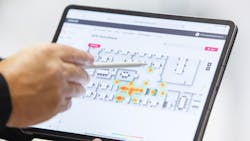Signify takes 'beyond lighting' literally beyond lighting (UPDATED)
When lighting company Signify this week announced new hardware and software aimed at helping facility managers monitor and improve the use of offices, there was one word that it notably underplayed in the press release. The word was “lighting.”
Meet Signify, the IT company.
Signify’s new "Interact Space analysis" tracks occupancy as well as temperature, humidity, and air quality. The idea is to give property operators insights on how to better reapportion space and to also intelligently alter the climate via the HVAC system.
It’s not an entirely new endeavor. Eindhoven, Netherlands–based Signify and other lighting companies have for a number of years marketed data-gathering and communication tools attached to luminaires to provide such insights. The concept is known as IoT (internet of Things) lighting. The industry often refers to it as “beyond lighting” — lighting with added internet-connected information features.
What’s different this time is that Signify is positioning Space independent of lights or the lighting infrastructure. Although the company can happily include it with lighting systems (similar to what it does with its existing Interact Office IoT lighting products), a spokesperson confirmed for LEDs Magazine that Space is not necessarily a lighting-related proposition.
“Indeed, this is an addition to what we still offer today,” he told LEDs, explaining that until now, the company integrated occupancy and environmental sensors into lighting fixtures.
“Now for 'Space analysis' our offer is based on two new, more data-rich and capable remote mount sensors,” the spokesperson said. “As such, indeed we can offer it as a combination with Interact Office, but also without lights.”
Space includes two Signify sensors, one for data occupancy and one for climatic and air quality recordings including CO2 levels, volatile organic compounds, and atmospheric pressure. The sensors have been part of Signify’s technology portfolio since the Dutch company’s Australian group Pierlite acquired SenseAgent IoT sensors and software from Australian firm Levaux in June 2022.
Signify charges an upfront fee for the product and a service fee for use of the software including the “dashboard.” The spokesperson declined to reveal pricing levels.
To be clear, Signify remains committed to also offering lighting-based space analysis.
“Our story is mix and match,” the spokesperson said. “Sometimes the value is carried by sensors in the lights, fully controlling the lighting state machine. Sometimes the value is fully carried by remote mount room-based sensors…The non-lighting part is to mix and match at the right granularity or situation at hand, using our knowledge and large volume of wireless communication.”
Signify hopes that the new offering provides a spark to what has been a slow IoT market for the lighting industry in general. “Beyond lighting” products and services emerged commercially roughly a decade ago. Since then, vendors have had some success selling internet-connected lighting controls. But mass sales of non-lighting functions such as space analysis, asset tracking, and wayfinding have been elusive.
Companies including Signify and competitors such as Fagerhult, Glamox, and Acuity continue to hold out hope.
Signify is not the first lighting-related outfit to add a non-lighting IT approach. Others have also attempted it. One of those, pioneer Gooee, went out of business two years ago after an eight-year run in smart lighting that included lighting and non-lighting products and services.
One major challenge is that the IT of IoT lighting competes against dyed-in-the-wool IT companies.
A middle ground is for lighting companies to partner with IT outfits, such as the recent Signify/Siemens pairing in the horticultural sector.
MARK HALPER is a contributing editor for LEDs Magazine, and an energy, technology, and business journalist ([email protected]).
*Updated Aug. 4, 2023 to clarify product offering name, add pricing information, and correct Levaux acquisition timing.
Follow our LinkedIn page for our latest news updates, contributed articles, and commentary, and our Facebook page for events announcements and more. You can also find us on Twitter.

Mark Halper | Contributing Editor, LEDs Magazine, and Business/Energy/Technology Journalist
Mark Halper is a freelance business, technology, and science journalist who covers everything from media moguls to subatomic particles. Halper has written from locations around the world for TIME Magazine, Fortune, Forbes, the New York Times, the Financial Times, the Guardian, CBS, Wired, and many others. A US citizen living in Britain, he cut his journalism teeth cutting and pasting copy for an English-language daily newspaper in Mexico City. Halper has a BA in history from Cornell University.





